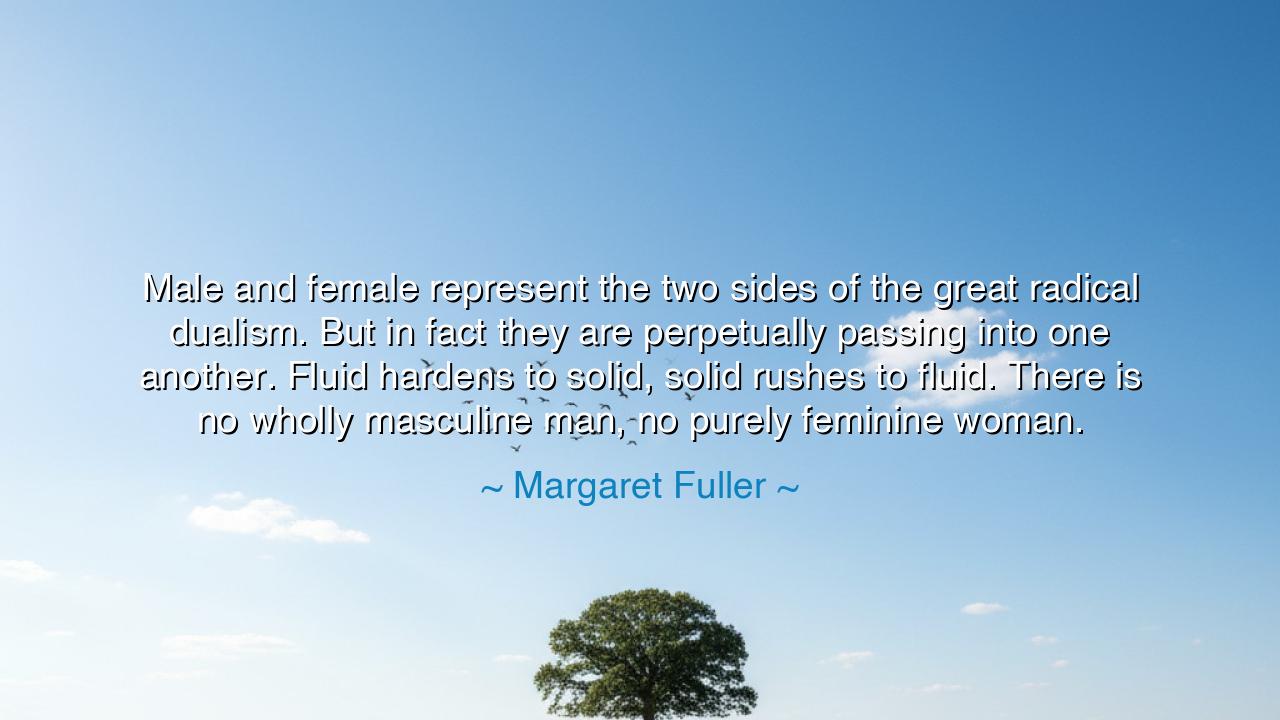
Male and female represent the two sides of the great radical
Male and female represent the two sides of the great radical dualism. But in fact they are perpetually passing into one another. Fluid hardens to solid, solid rushes to fluid. There is no wholly masculine man, no purely feminine woman.






"Male and female represent the two sides of the great radical dualism. But in fact they are perpetually passing into one another. Fluid hardens to solid, solid rushes to fluid. There is no wholly masculine man, no purely feminine woman." — Margaret Fuller
This saying, profound as the breath of ancient oracles, speaks to the eternal dance between masculine and feminine, the twin forces that sustain all creation. Margaret Fuller, a thinker of the transcendental age, saw that life itself is woven from two threads — strength and softness, logic and intuition, sun and moon. To her, male and female were not fixed walls dividing humanity, but flowing rivers, winding and merging, shaping each other’s course. In her words resounds a truth older than nations: that the universe itself is born of duality, yet strives toward unity.
From the dawn of myth, the ancients spoke of this sacred balance. In China, it was yin and yang, the dark and the light, each containing the seed of the other. In Greece, Plato told of souls split in two, longing for reunion. In India, the god Shiva danced with Shakti, the cosmic feminine, and from their embrace arose the world. Fuller’s words are the echo of these same truths — that neither the masculine nor the feminine is complete in isolation. Each is a mirror, reflecting and deepening the other.
Yet humankind, blinded by pride, has long sought to draw a hard line where nature has drawn none. For centuries, men were taught to be stone — unyielding, without tears — while women were told to be water — yielding, without will. But fluid hardens to solid, and solid rushes to fluid; the two are not enemies, but phases of the same being. Strength without tenderness becomes cruelty; tenderness without strength becomes fragility. The perfect human soul, like tempered steel, is forged from both fire and water.
Consider, for instance, the life of Joan of Arc, that radiant spirit of France. In her burned the fire of a warrior and the compassion of a saint. She led armies with a voice of command, yet wept in prayer like a child before God. In her courage was gentleness, in her faith was iron. She defied her time’s narrow vision of womanhood — yet she was no less woman for it. Indeed, she was more. Her life revealed that the masculine and feminine are not chains to bind us, but wings that lift us beyond the ordinary.
Fuller herself, in the 19th century, stood among men who ruled thought and dared to speak as their equal. She wrote not as a woman imitating men, but as a soul claiming its full measure. Her vision was not of women overthrowing men, but of all humanity awakening to the divine androgyny within — that sacred harmony where intellect and intuition, reason and emotion, courage and compassion dwell together. She foresaw a future in which both man and woman would learn to draw from the well of the other, becoming whole.
Thus, the message to us, her distant heirs, is clear: do not imprison yourself in the shadow of false division. To be fully human is to be both firm and gentle, both thinker and dreamer, both sword and song. The heart that dares to love and the mind that dares to reason are not opposites, but companions in the same divine journey. Embrace both, and you will walk in the balance of the stars.
Let every man, then, learn to listen as well as lead; and every woman, to command as well as care. Let each of us seek the unity within the duality, for the soul that reconciles its opposites becomes a vessel of harmony in a world at war with itself. Be fluid when the world grows rigid; be solid when it melts into chaos. In this balance lies wisdom, strength, and peace — the true fulfillment of the eternal law that Margaret Fuller, with the vision of a prophet, named: the great radical dualism.






AAdministratorAdministrator
Welcome, honored guests. Please leave a comment, we will respond soon